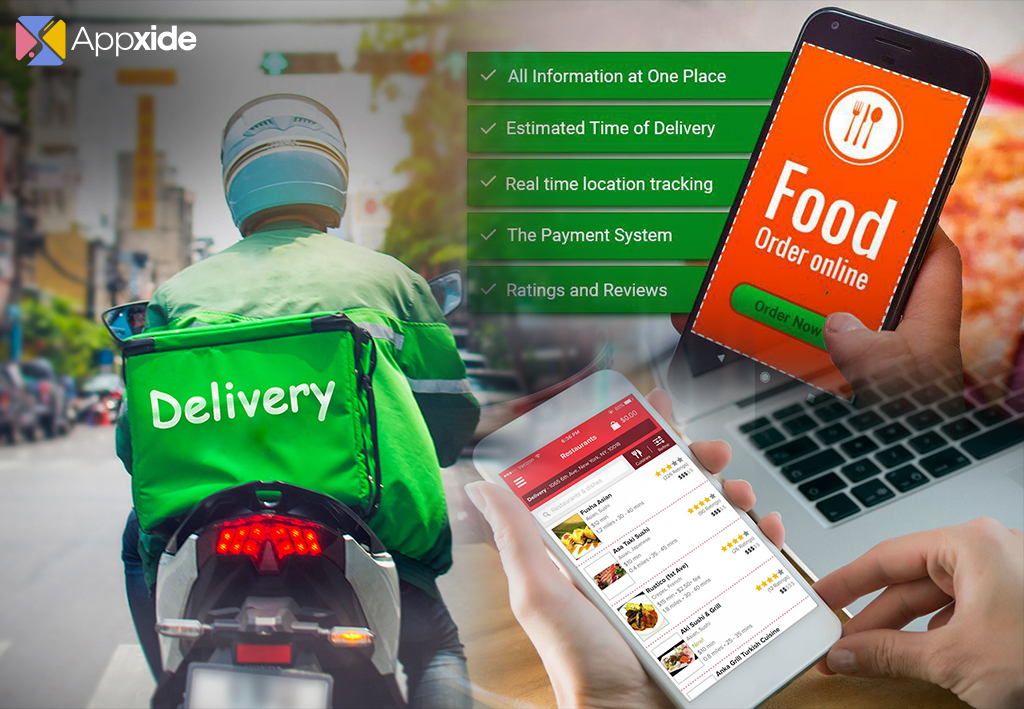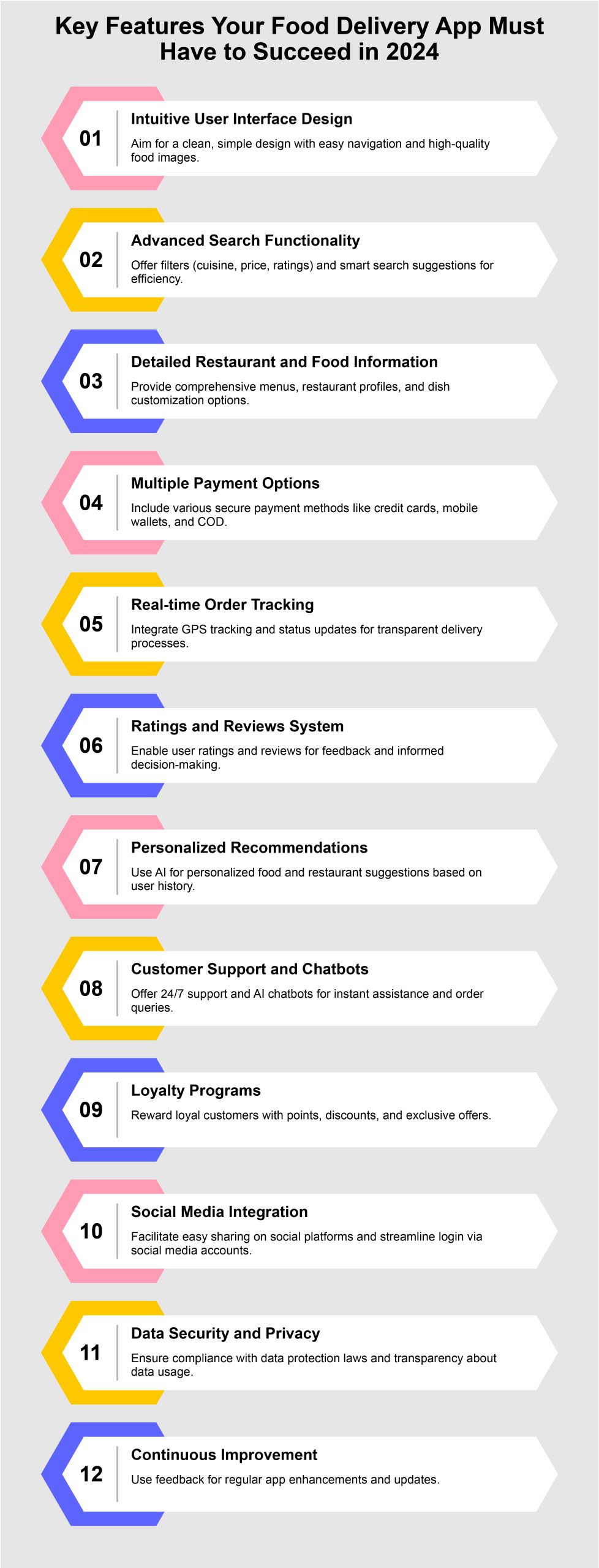Let's Get You Started

Let's Get You Started




The convenience of food delivery apps has become more than just a luxury—it’s a necessity for many. Whether it’s a craving for late-night snacks or the need for a quick lunch during a busy workday, food delivery apps have got you covered. But have you ever wondered about the journey behind these apps? Specifically, the cost to develop a food delivery app? If you’re an entrepreneur or a business looking to dive into this booming market, you’re in the right place. Let’s reveal the layers of costs, features, and strategies to launch a successful food delivery app.
Before we dive into the costs, understanding the essential features and components of a food delivery app is crucial. These are the building blocks that not only determine the initial development cost but also influence the app’s long-term success.
The cost to develop a food delivery app isn’t a one-size-fits-all figure. Several factors play into the total cost, including the app’s complexity, the chosen platform (iOS, Android, or both), and the geographic location of your development team. Let’s break down these factors to get a clearer picture of the expenses involved in acquiring top-notch food delivery app development services.
Your app’s cost will increase as its complexity rises. A basic app with essential features might be on the lower end of the spectrum, while an app with advanced features like AI-based recommendations or blockchain for secure transactions could significantly increase the budget.
Developing for iOS, Android, or both? Each platform has its own set of requirements and development costs. While targeting both platforms increases your potential user base, it also raises the development cost.
The geographic location of your mobile app development solutions team can dramatically affect the overall cost. Developers in North America and Western Europe typically charge more than those in Eastern Europe or Asia.

The importance of robust security measures in a food delivery app cannot be overstated. Ensuring the safety of user data and transactions is not just about protecting your customers; it’s about safeguarding the integrity and reputation of your business. Let’s delve into the essential security practices that are paramount for any food delivery app aiming to establish trust and reliability in the competitive market.
Encryption refers to the procedure by which data is encoded to restrict access to authorized individuals or entities. Implementing end-to-end encryption for all data transactions within your app, including user credentials, payment information, and personal details, is crucial. This ensures that even if data is intercepted during transmission, it remains unreadable and secure from unauthorized access.
Integrating reputable and secure payment gateways is another vital step in protecting financial transactions. These gateways are equipped with advanced encryption and security protocols, such as SSL (Secure Socket Layer) certification, which creates a secure link between the user’s device and the server. Opting for payment solutions that comply with PCI DSS (Payment Card Industry Data Security Standard) further guarantees that cardholder data is handled safely, reducing the risk of fraud and breaches.
Adhering to global and local data protection laws, such as GDPR (General Data Protection Regulation) in Europe and CCPA (California Consumer Privacy Act) in the USA, is non-negotiable. These regulations mandate the responsible collection, storage, and use of personal information. They also require businesses to be transparent about their data practices and provide users with control over their personal data. Compliance not only ensures legal integrity but also builds user trust in your app’s commitment to privacy and security.
The digital environment is in a constant state of change, and potential risks emerge on a regular basis. Conducting periodic security audits allows you to identify vulnerabilities within your app and infrastructure. These audits, coupled with regular updates and patches, fortify your app against the latest security threats. Keeping your software up-to-date is a proactive measure that prevents attackers from exploiting known vulnerabilities.
Implementing robust authentication mechanisms is critical to verify the identity of users and prevent unauthorized access. Options like two-factor authentication (2FA), biometrics (fingerprint or facial recognition), and OTP (One Time Password) significantly enhance security. Additionally, authorization protocols ensure that users can only access the features and data relevant to their role, further minimizing the risk of data breaches.
While technical measures are indispensable, educating your users on security best practices plays a crucial role in safeguarding their data. Encouraging strong, unique passwords, awareness about phishing scams, and the importance of secure Wi-Fi networks can empower users to protect their information proactively.
To give you a better understanding, here’s a table estimating the cost of developing a food delivery app based on complexity:
| App Complexity | Features Included | Development Time | Estimated Cost |
| Basic | User registration, menu browsing, order placement, and payment gateway. | 3-4 months | $10,000 – $20,000 |
| Medium | All basic features plus real-time tracking, ratings, and reviews. | 5-7 months | $20,000 – $40,000 |
| Advanced | All the above, plus personalized recommendations, loyalty programs, and more. | 8-12 months | $40,000 – $100,000+ |
Remember, these figures are estimates and can vary based on your specific requirements and the development team you choose.
Developing a food delivery app is a journey that requires careful planning and execution. Here are the steps you’ll typically follow:
Developing a food delivery app is an exciting venture with the potential for significant returns. However, it requires a substantial investment of time, resources, and strategic planning. By understanding the key factors that influence development costs and following a structured development process, you can set the stage for a successful launch. Remember, the ultimate goal is to create an app that not only meets but exceeds user expectations, fostering loyalty and driving growth in the competitive food delivery market.
A 1: The development time can range from 3 months for a basic app to over 12 months for an app with advanced features and customizations.
A 2: Yes, focusing on an MVP with essential features can significantly reduce initial costs. You can add more features based on user feedback and app performance.
A 3: Both platforms have significant user bases. Your choice should depend on your target audience's preferences. Developing for both platforms maximizes your reach but increases the cost.
A 4: Focus on unique features, exceptional user experience, and personalized services. Continuous improvement based on user feedback is key to staying relevant.
A 5: Ongoing costs include server fees, maintenance, updates, marketing, and customer support. These are crucial for keeping your app running smoothly and retaining users.

Welcome to Appxide, where innovation meets utility in the world of app development. Our mission is to craft cutting-edge digital solutions that simplify lives and spark connections. With a diverse portfolio that traverses multiple sectors, we are committed to excellence and user-centric design. Stay tuned to our blog for the latest in tech, insights, and the stories behind our projects. Dive into the future with us – where every app we create is a step towards the extraordinary.